You want someone to tell you what to buy.
Not a newsletter with market commentary. Not a screener with 10,000 stocks to filter. Not a research platform where you do your own analysis. You want an advisor — someone who looks at the market, identifies opportunities, and says “buy this.”
That’s what separates stock advisors from stock newsletters and research tools. Newsletters inform. Tools enable. Advisors recommend. And when you’re searching for the “best stock advisor,” you’re looking for guidance you can act on.
I’ve subscribed to most of these services over 20+ years of investing. Some delivered. Some didn’t. This guide exists to save you the subscription fees I wasted learning the difference.
December 2025 Update: The S&P 500 is up 16.6% year-to-date, but the dispersion between winners and losers has never been wider. The top 10 stocks now represent 43% of the index — extreme concentration that makes stock selection more important than ever. An index fund gives you the average. A good stock advisor captures the outliers.
The Quick Answer: Best Stock Advisors Ranked
Motley Fool Stock Advisor is the best stock advisor for most investors. Twenty-three years of market-beating returns (+982% vs S&P 500’s +188%), a complete portfolio-building framework, and a $99 entry price make it the lowest-regret starting point.
| Rank | Service | Best For | Track Record | Price | Advisory Level |
|---|---|---|---|---|---|
| 🥇 | Stock Advisor | Long-term growth | +982% since 2002 | $99/yr | Full Advisory |
| 🥈 | Alpha Picks | Quant-driven picks | +264% since 2022 | $449/yr | Full Advisory |
| 🥉 | Epic | Diversified strategies | 4 strategies, 5 picks/mo | $299/yr | Full Advisory |
| 4 | StockInvestor | Moat-based value | 24 years, real-money portfolios | $170/yr | Full Advisory |
| 5 | 7investing | Innovation focus | Since 2020 | $199/yr | Full Advisory |
| 6 | Zacks Premium | Earnings-focused | Since 1988 | $249/yr | Guided Research |
| 7 | Morningstar Investor | DIY analysts | N/A (tool) | $199/yr | DIY Tools |
| 8 | SA Premium | Research junkies | N/A (tool) | $269/yr | DIY Tools |
The Scenario Cheat Sheet
- Want someone to tell you exactly what to buy? → Stock Advisor
- Trust algorithms over human analysts? → Alpha Picks
- Have $50K+ and want multiple strategies? → Epic
- Prefer undervalued stocks with economic moats? → Morningstar StockInvestor
- Excited about disruptive innovation? → 7investing
- Follow earnings estimates religiously? → Zacks Premium
- Want to do your own research with pro tools? → Morningstar Investor
- Want diverse opinions + quant ratings? → SA Premium
Why Trust This Ranking?
I’ve been investing for over two decades. I’ve subscribed to these services with real money — not for “free trial reviews” but with positions on the line. I’ve held their picks through crashes and rallies. I know which ones I trusted when my portfolio dropped 40%.
How we evaluated:
-
Advisory clarity. Does the service tell you what to buy with conviction? Or does it give you tools and expect you to figure it out? True advisors recommend. Tools inform.
-
Verified track records. Not the cherry-picked numbers from marketing pages. We calculated returns including the losers, the fees, and the positions no one talks about.
-
Portfolio guidance. A stock pick is worthless without context. The best advisors tell you how much to buy, when to add, and how the pick fits your overall portfolio.
-
Real-world usability. A service that returns 750% means nothing if 80% of subscribers quit during the first drawdown. We factored in how real users experience these products.
This isn’t sponsored content. We use affiliate links (we get paid if you subscribe), but the rankings are based on what I’d actually recommend to a friend.
Understanding Advisory Levels
Before diving into rankings, understand what you’re choosing between:
Full Advisory Services tell you exactly what to buy. They provide specific stock recommendations with conviction rankings, target allocations, and often portfolio frameworks. You follow their guidance. Examples: Stock Advisor, Alpha Picks, Epic.
Guided Research Services provide ratings or scores that guide your decisions, but you must interpret them and build your own portfolio. The service says “this stock is a Strong Buy,” but you decide whether to act. Example: Zacks Premium.
DIY Research Tools provide data, analysis, and ratings, but no specific recommendations. You use their tools to do your own research. Examples: Morningstar Investor, Seeking Alpha Premium.
If you’re searching for a “stock advisor,” you probably want Full Advisory. But I’ve included all three levels because understanding the spectrum helps you choose.
1. Motley Fool Stock Advisor — The Gold Standard

Patient growth investors who hold through volatility for 5+ years
Every “best stock advisors” list starts here, and there’s a reason: 23 years of beating the market isn’t a fluke. When someone asks me “what’s the one service I should try?” this is still my answer — even though it’s not the cheapest or the newest.
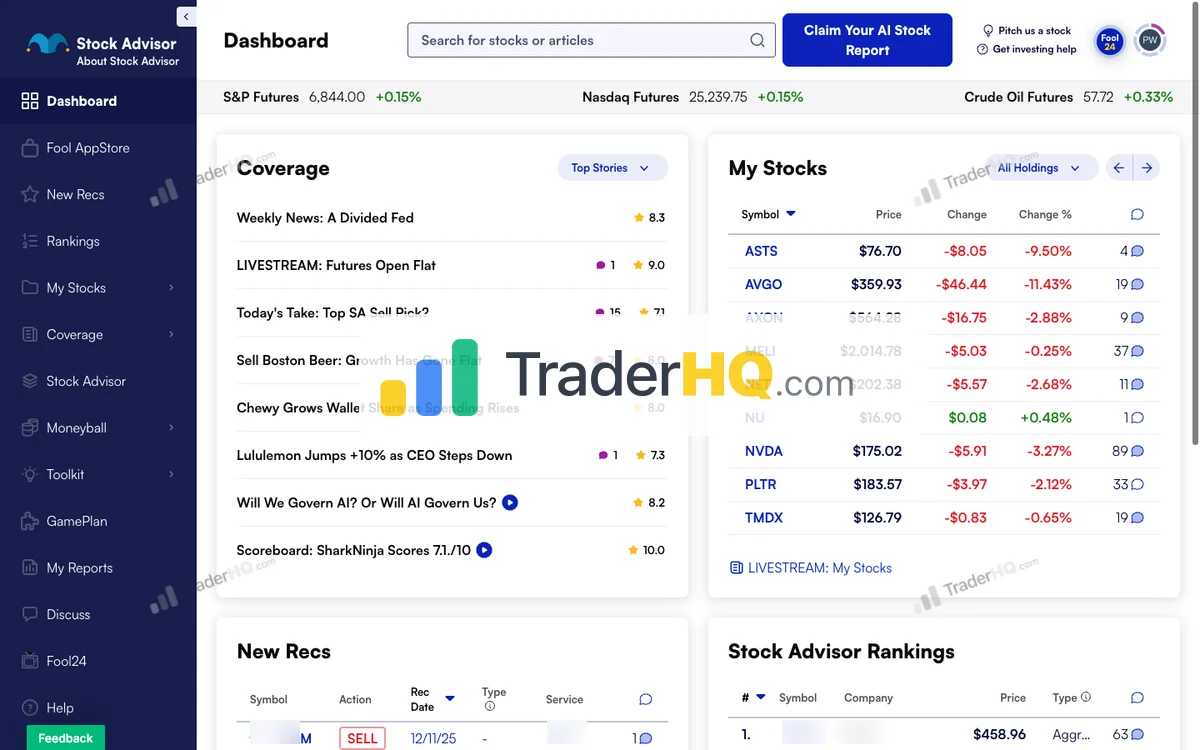
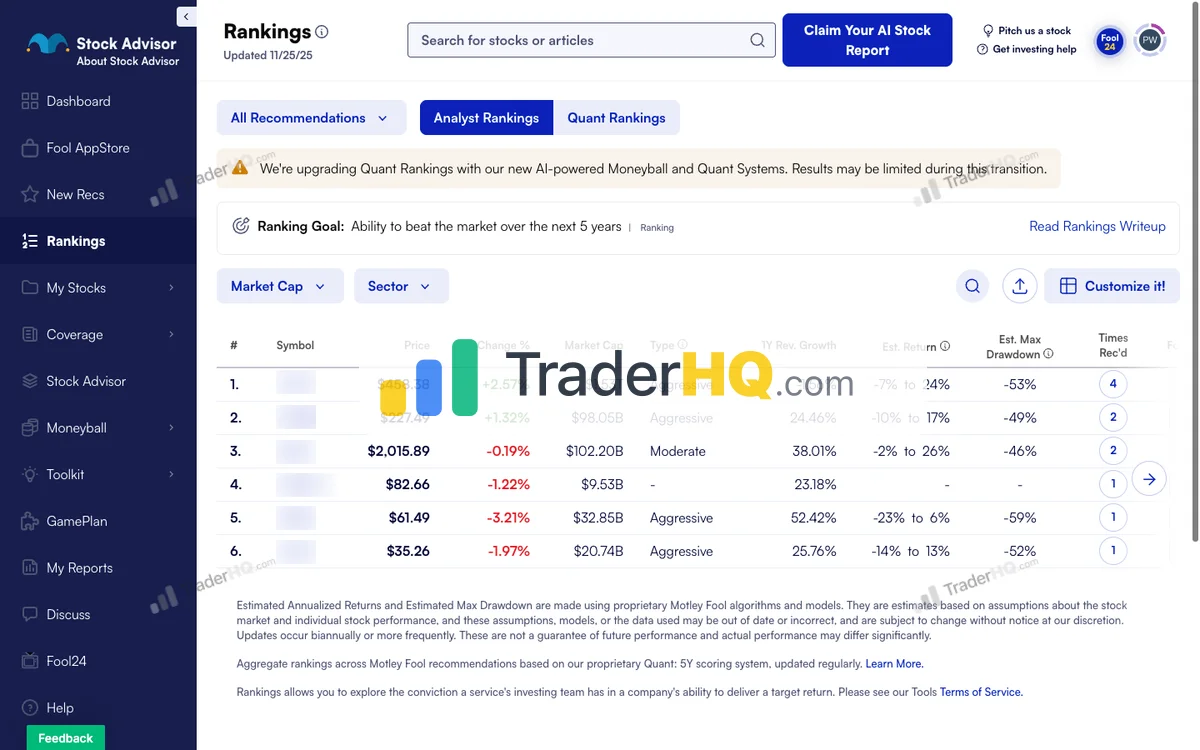
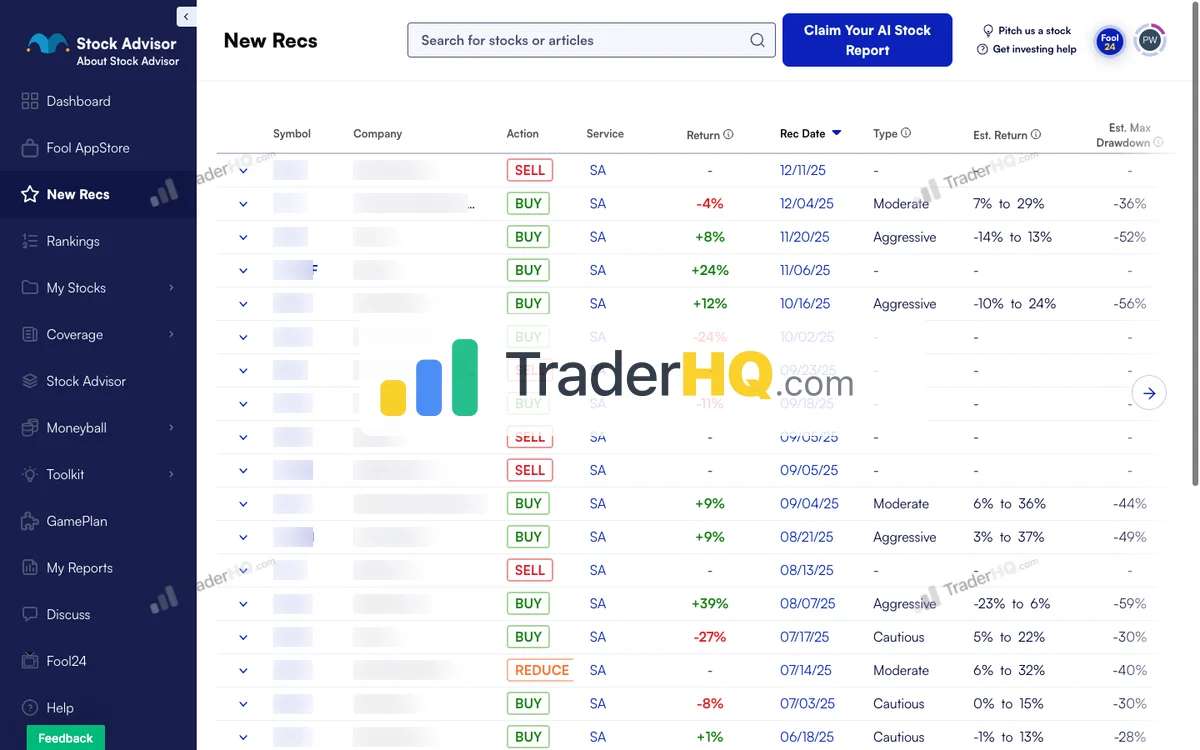
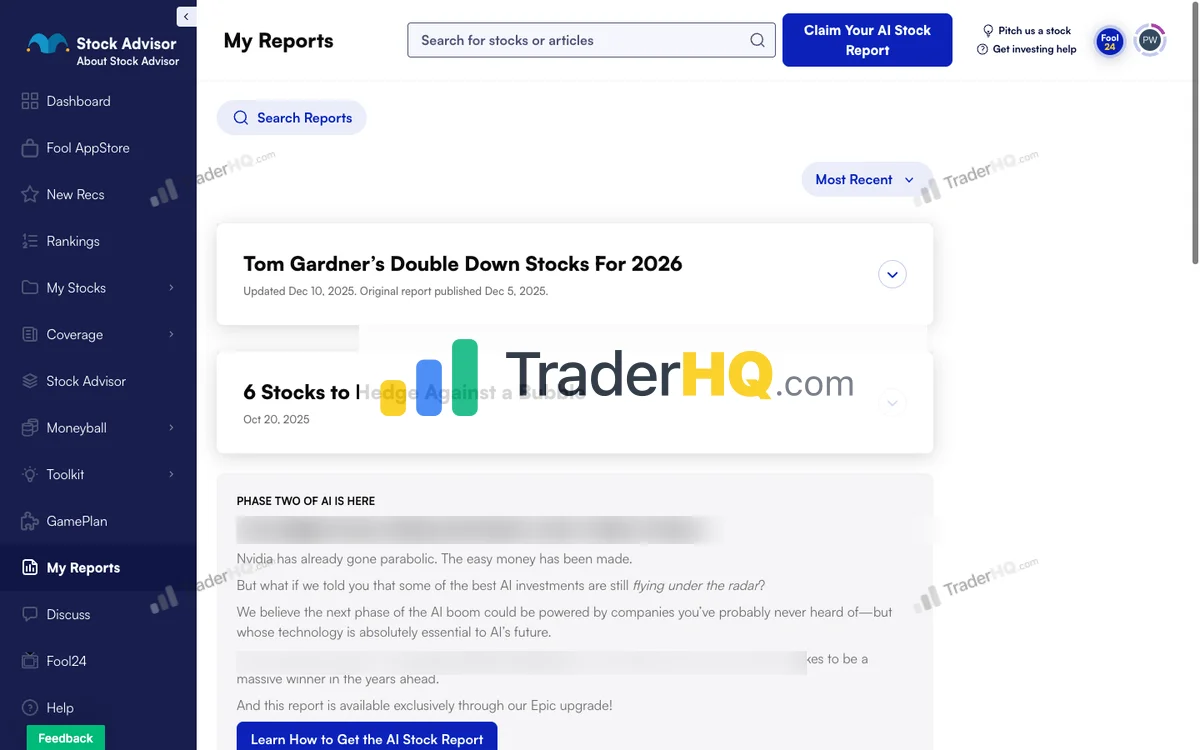
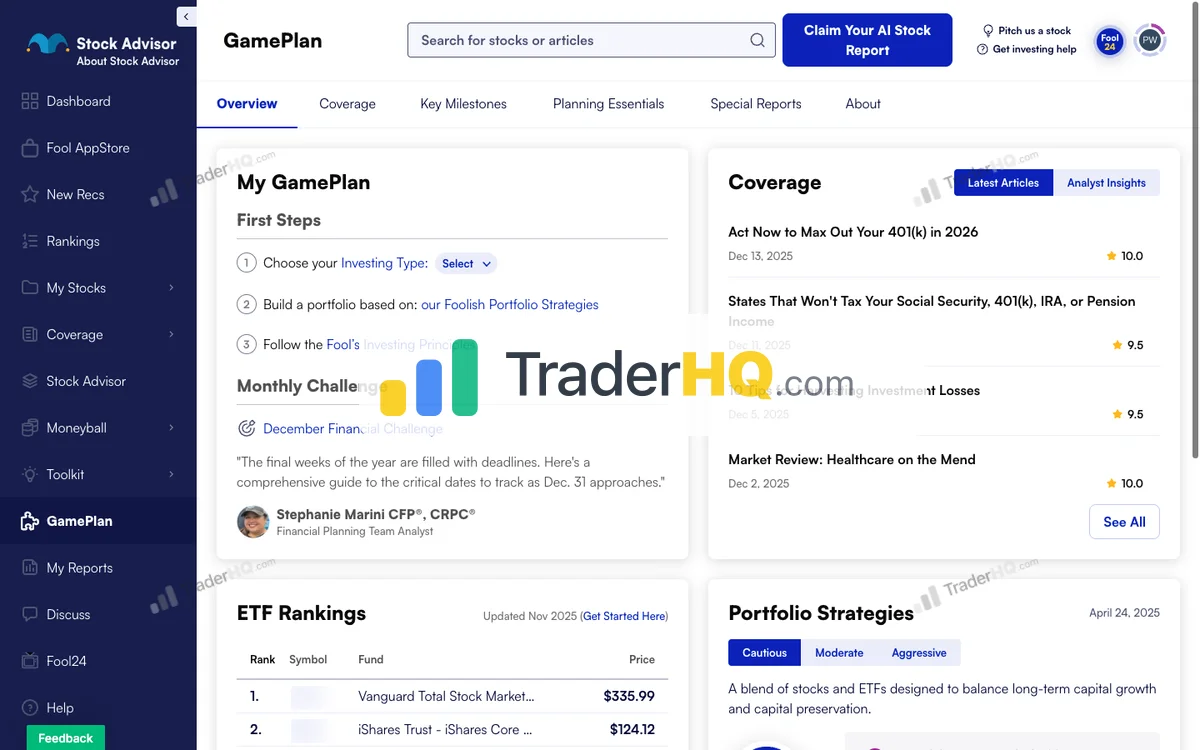
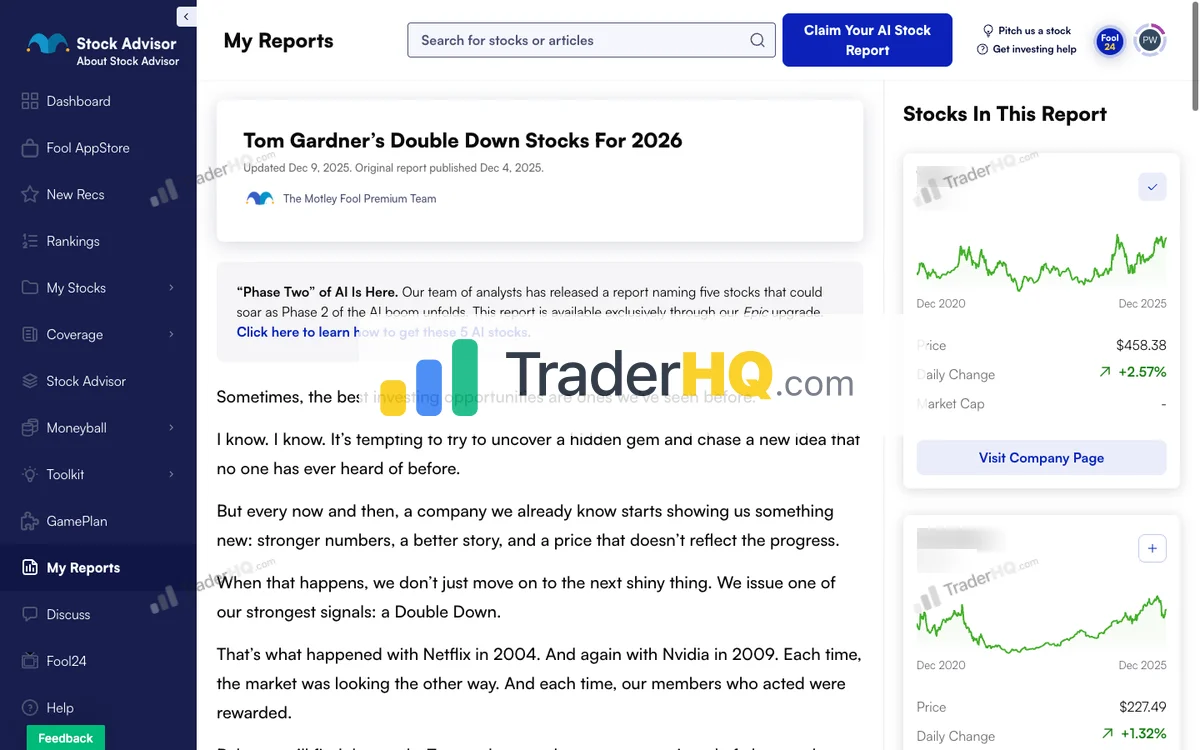
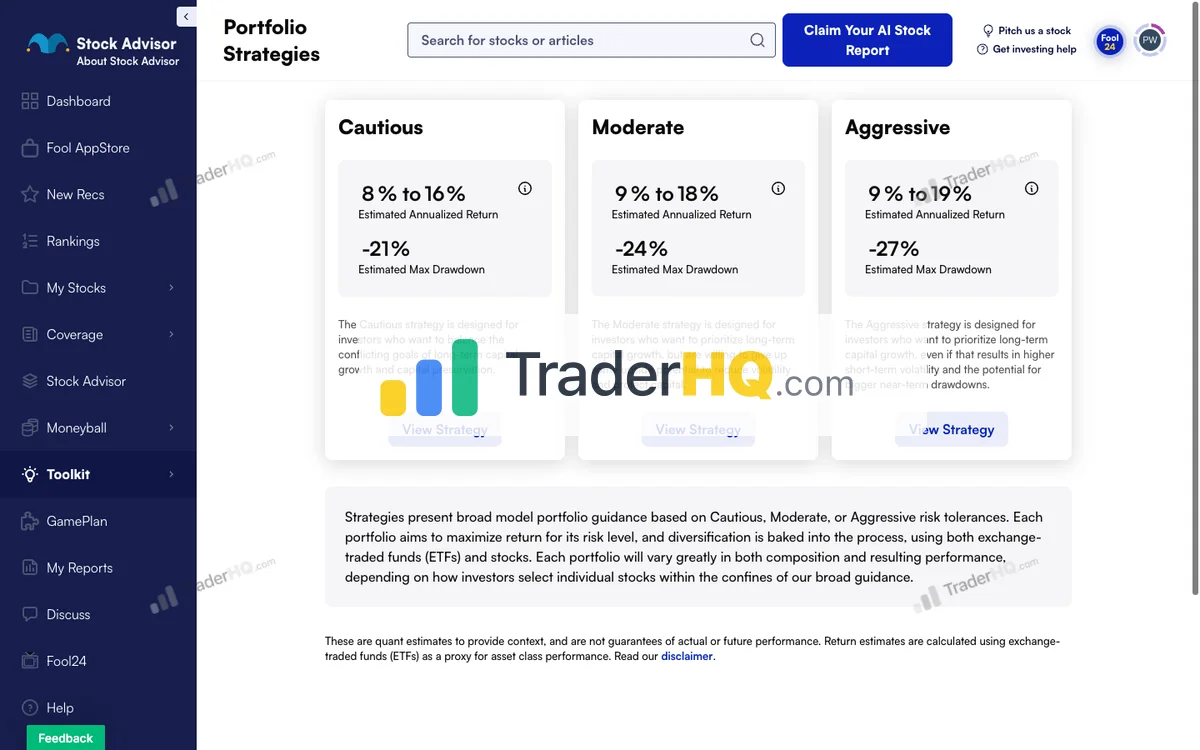
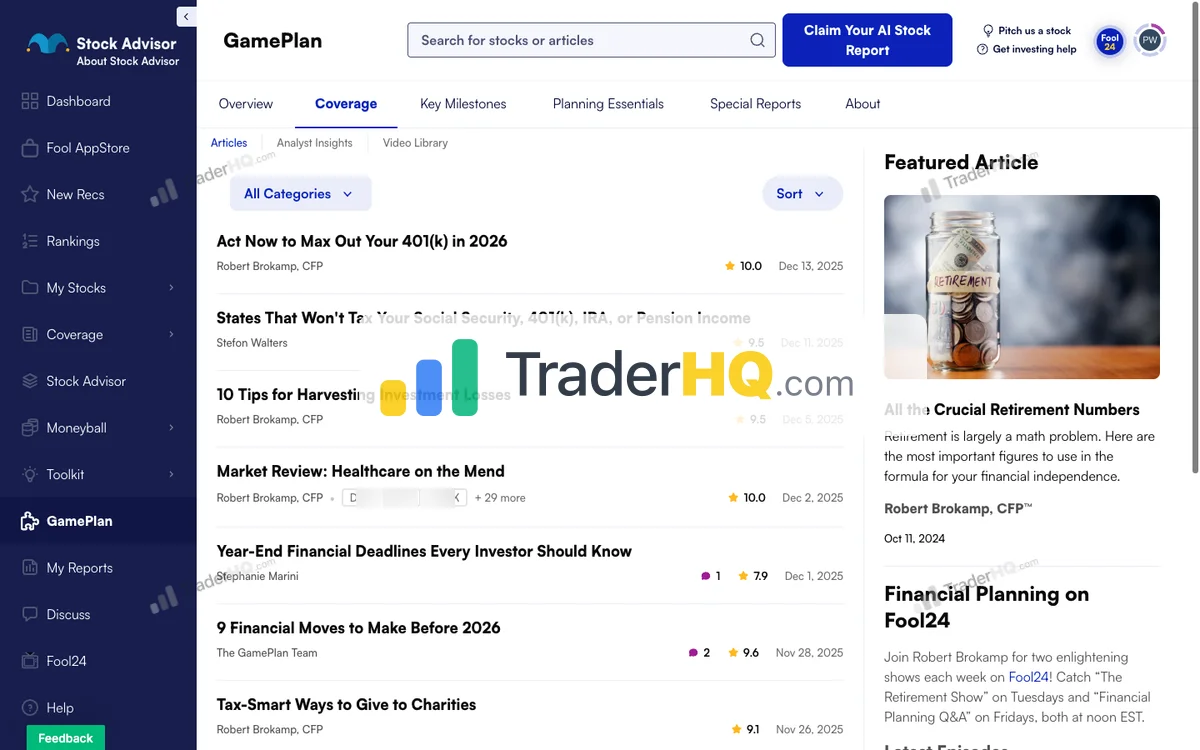
8 views
The Track Record
$10,000 invested in Stock Advisor picks in 2002 would be worth approximately $108,000 today. The same money in an S&P 500 index fund? About $29,000. That’s not marketing spin — I’ve verified it against the actual historical recommendations, including the losers.
The numbers that matter:
- +982% cumulative return (vs S&P 500’s +188%)
- 91.9% win rate on picks held 10+ years
- 3,951% average return on decade-plus holdings
- 57% win rate on first-year picks (the honest number)
That last stat is crucial. Stock Advisor isn’t a trading service. The first-year win rate is barely better than a coin flip. But hold for a decade? 91.9% of picks are winners.
How It Works
Two new stock recommendations each month from the Motley Fool’s analyst team. Each comes with a deep-dive thesis explaining why this company can compound for decades. You’re not just getting a ticker — you’re getting conviction.
But the real value isn’t the picks. It’s the framework:
- Three Portfolio Strategies (Cautious/Moderate/Aggressive) calibrated to different risk tolerances
- Foundational Stocks — 10 highest-conviction core holdings with explicit risk classifications
- Moneyball Database — 344 stocks with quantitative projections for independent research
- Monthly Rankings — Current “Best Buys Now” based on analyst conviction
This is a complete portfolio-building system, not just stock tips.
Pricing
$99/year for new members (50% off regular $199 price). That’s $8.25/month for 24 stock picks plus the entire framework. The math works for portfolios as small as $10,000.
Best For
Patient growth investors with 5+ year horizons who want someone to tell them what to buy AND how to build a portfolio. You need the temperament to hold through 30-50% drawdowns without panic-selling.
The Trade-Off
Volatility is the price of admission. Stock Advisor’s best performers have all crashed at some point. Netflix dropped 80%. Amazon dropped 90% during the dot-com bust. If you’d panic-sell during a crash, save your money — you’ll sell at the bottom and miss the recovery.
Also: the upsell pressure is relentless. Motley Fool will email you constantly about upgrading to Epic or Epic Plus. It’s annoying, but the core Stock Advisor service delivers.
For the complete analysis including every pick and return, read our Stock Advisor review.
Try Stock Advisor — $99/Year, 30-Day Guarantee
2. Alpha Picks by Seeking Alpha — The Quant Advisor

Data-driven investors who trust algorithms over human opinion
Alpha Picks represents something genuinely different: a pure quantitative system with zero human discretion, complete transparency on every position, and a track record that’s impossible to dismiss.
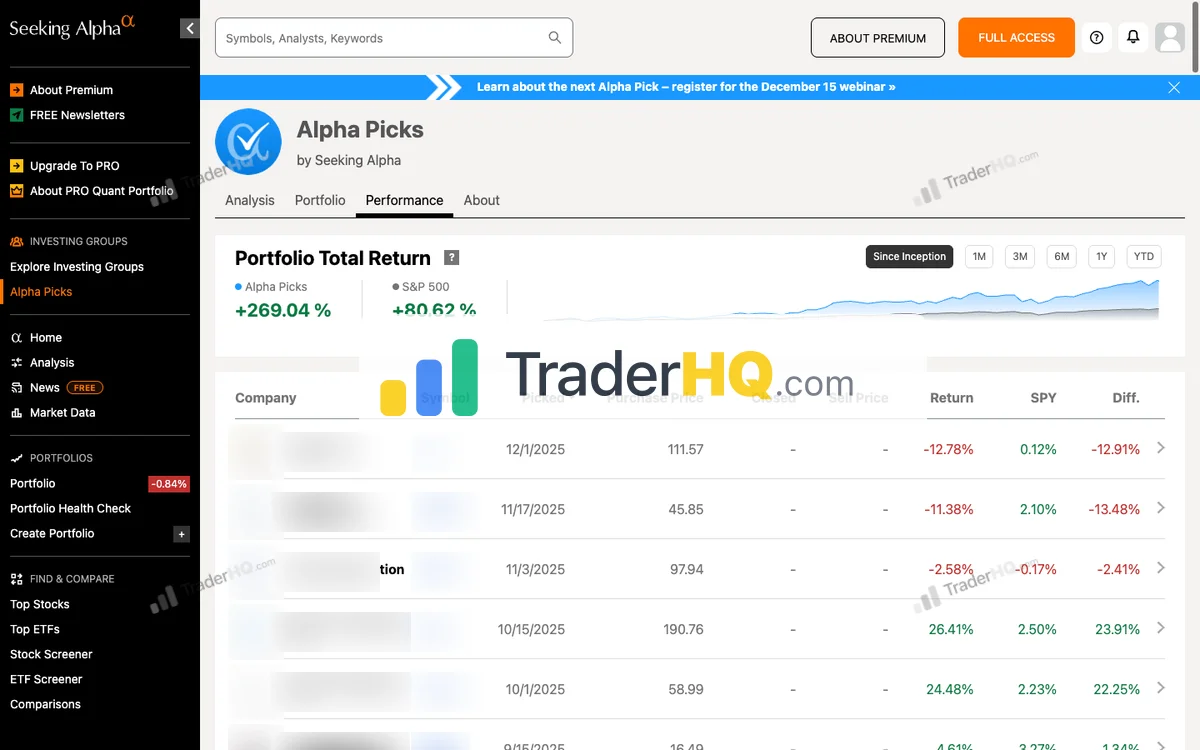
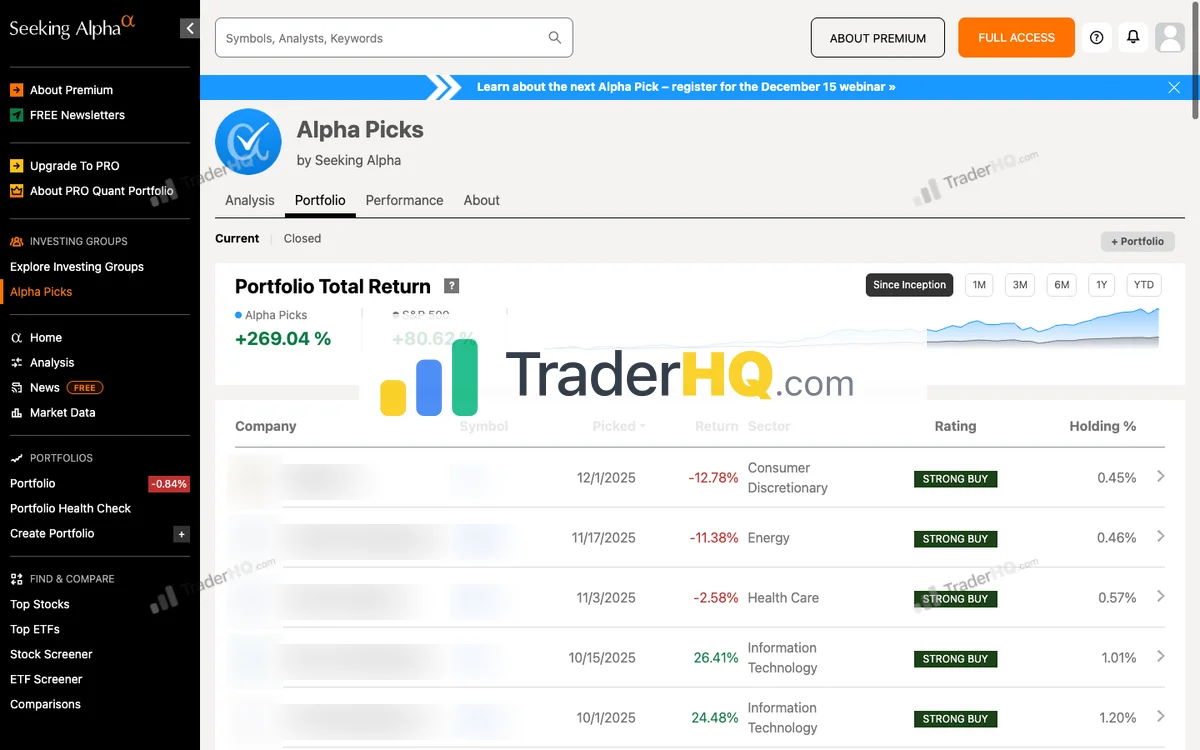
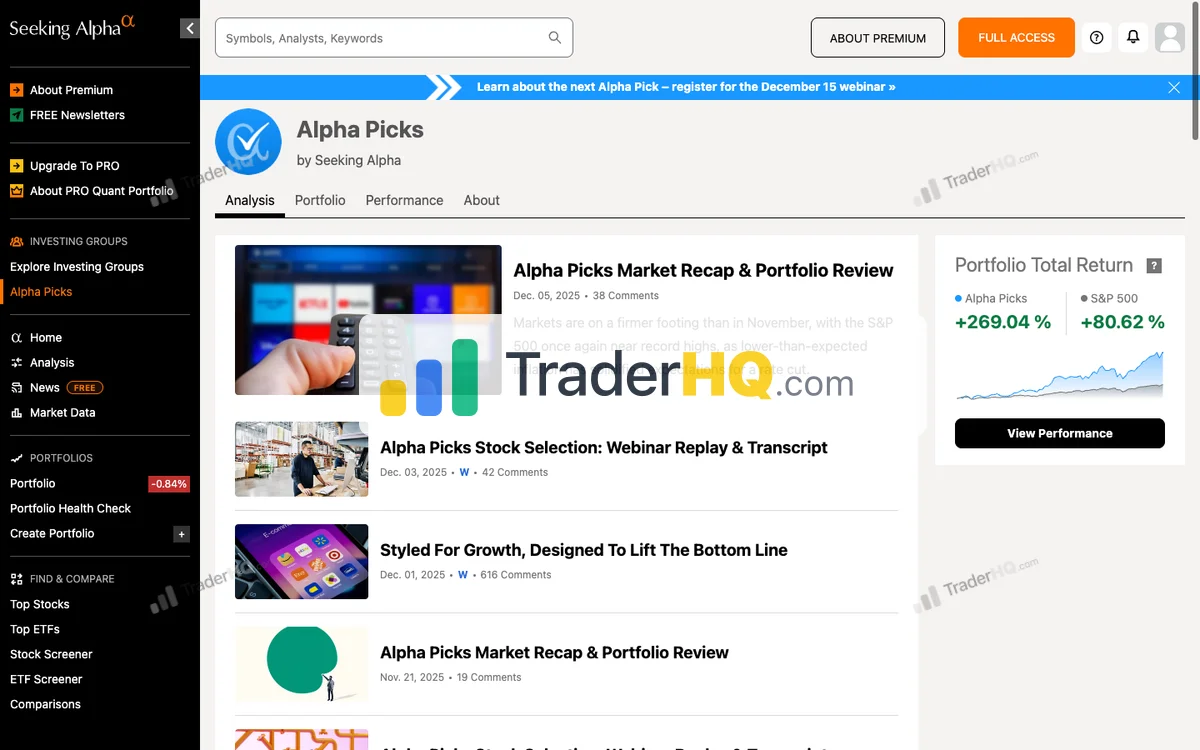

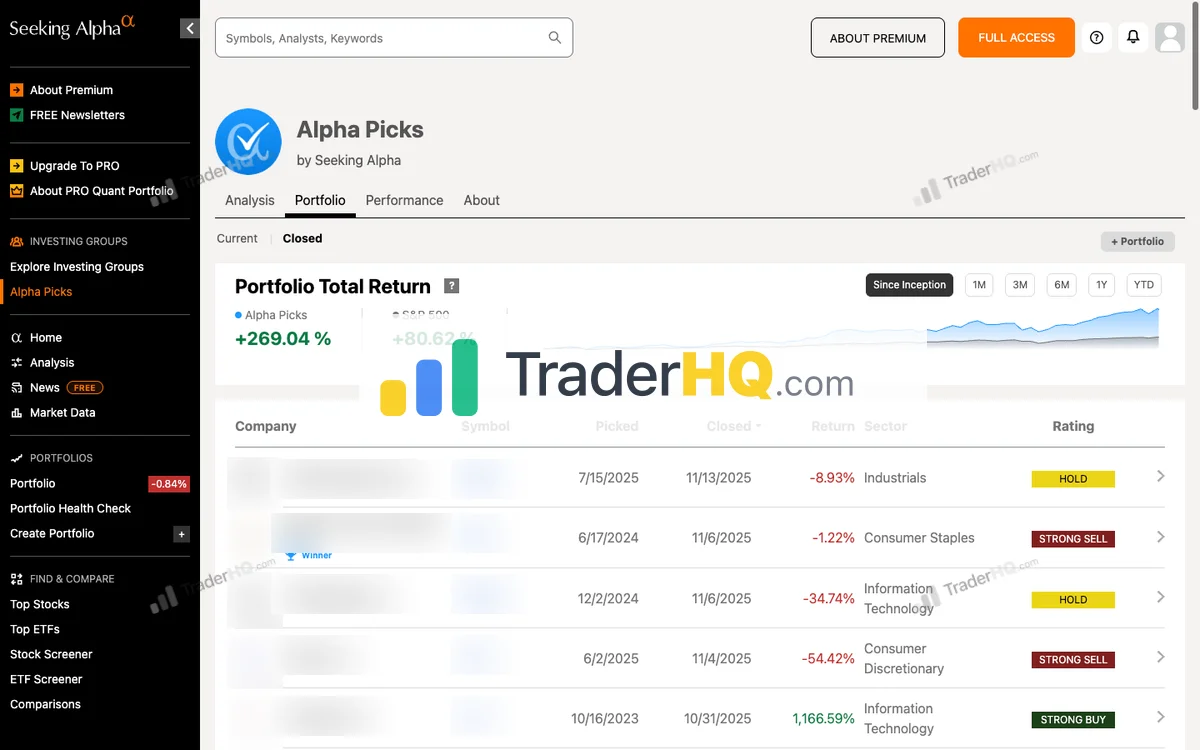

6 views
The Track Record
+264% return since July 2022 versus +79% for the S&P 500. That’s documented across 88 positions with every entry date, exit date, and return visible. Not cherry-picked winners — the complete record.
The numbers:
- 71% win rate across all closed positions
- Three ten-baggers (+1,571%, +1,167%, +969%)
- Fifteen doublers (100%+ returns)
- Third-party verified by S&P Global
The time curve is everything: positions held under one year show 54% win rate and 5% average return. Positions held 1-3 years? 78% win rate and 119% average return. The algorithm needs time to work.
How It Works
A proprietary quantitative model analyzes thousands of stocks and selects two per month. No human analyst decides “I like this company’s management.” The algorithm identifies statistical patterns that predict outperformance.
You get:
- Two picks per month with entry prices
- Systematic exit signals when the model says sell
- Complete position transparency — every active and closed position visible
- No human bias — the algorithm doesn’t get emotional
This is “advisor” in the purest sense: the model tells you what to buy and when to sell. You follow the system.
Pricing
$449/year for new members (10% off regular $499 price). No refunds — annual billing only. The higher price point and no-refund policy mean you need conviction before subscribing.
Best For
Data-driven investors who trust algorithms over human opinion. If you believe markets are ultimately mathematical and human analysts introduce bias, Alpha Picks is your service. You need 1-3+ year holding periods and comfort with a “black box” you can’t fully understand.
The Trade-Off
The methodology is opaque. You know that it works, but not why it selects specific stocks. If you need to understand the thesis behind every pick, this isn’t for you.
Also: no portfolio construction guidance. Alpha Picks tells you what to buy, but not how much or how it fits your overall allocation. You’re on your own for position sizing.
Curious how it compares to Stock Advisor? See our Alpha Picks vs Stock Advisor breakdown.
Explore the full details in our Alpha Picks review.
Try Alpha Picks — Quant-Driven Stock Selection
3. Motley Fool Epic — The Comprehensive Advisor
Epic occupies the strategic middle ground in Motley Fool’s hierarchy — more than Stock Advisor’s two monthly picks, less overwhelming than Epic Plus’s daily recommendations. For investors with $50,000+ portfolios who want diversified exposure across strategies, this is the sweet spot.
No screenshots available for motley-fool-epic
What You Get
Five monthly stock picks from four distinct strategies:
- Stock Advisor — Core growth picks (the flagship)
- Rule Breakers — Disruptive innovators with multi-bagger potential
- Hidden Gems — Small-cap opportunities you won’t find elsewhere
- Dividend Investor — Income-focused positions
Plus full access to:
- Fool IQ — Complete research database
- Moneyball — Quantitative projections for every stock
- Quant System — Estimated return ranges and max drawdown for each pick
The Track Records
| Strategy | Return | vs S&P 500 | Timeframe |
|---|---|---|---|
| Stock Advisor | +958% | +192% | 23.8 years |
| Rule Breakers | +342% | +176% | 21.2 years |
| Hidden Gems | +65% | +3% | 7.3 years |
| Dividend Investor | +9.5% | +54% | 6 years |
The honest assessment: three of four strategies beat the market significantly. Dividend Investor has underperformed — income investors might look elsewhere.
Pricing
$299/year with code EPICSALE (40% off regular $499 price). That’s $25/month for 60 annual picks across four strategies. For portfolios over $50,000, the math is compelling.
Best For
Committed investors who want diversified exposure across growth, small-cap, and income strategies without managing multiple subscriptions. You need the capital to act on 5 picks per month and the organization to track multiple strategies.
The Trade-Off
More picks means more decisions. If you’re overwhelmed by two picks per month, five will bury you. Epic works best for investors who can systematically evaluate and implement recommendations.
The upsell pressure is even more intense than Stock Advisor. Motley Fool really wants you in Epic Plus.
Wondering how Epic compares to Stock Advisor? Check our Epic vs Stock Advisor comparison.
Read our in-depth Epic bundle review for the full breakdown of all four strategies.
Try Epic — 4 Strategies, 5 Picks/Month
4. Morningstar StockInvestor — The Moat-Based Advisor
Morningstar StockInvestor is something rare: a stock-picking newsletter backed by real money. Morningstar invests its own capital (~$945,000 in the Tortoise portfolio alone) into the stocks it recommends. That’s not hypothetical paper trading — it’s skin in the game.
The Track Record
The service has run two real-money model portfolios since June 2001 — 24 years through dot-com aftermath, the 2008 financial crisis, COVID crash, and the 2022 bear market:
- Tortoise Portfolio — Conservative, wide-moat companies. ~$945,000 in real capital. Holdings include Berkshire Hathaway (since 2001) and General Dynamics (since 2003).
- Hare Portfolio — More aggressive growth opportunities with higher volatility tolerance.
Specific performance returns aren’t publicly disclosed, but 24 years of continuous operation with real money is a credibility signal that marketing claims can’t match.
How It Works
The methodology is built on Morningstar’s proprietary Economic Moat framework:
- Wide Moat — Durable competitive advantage likely to persist 20+ years
- Narrow Moat — Advantage likely to persist 10+ years
- No Moat — No sustainable competitive advantage
Each recommendation includes Fair Value estimates, Moat ratings, and Capital Allocation scores — the same institutional-grade research that hedge funds pay $15,000+/year to access.
Pricing
$170/year — one of the most affordable advisory services with this pedigree. No promotional pricing typically available, but the base price is already competitive.
Best For
Value-oriented investors who believe in buying quality companies at fair prices and holding for decades. You appreciate fundamental analysis, want to understand why a company has durable advantages, and are comfortable with concentrated portfolios (~31 holdings).
The Trade-Off
Low turnover means this isn’t for active traders. The portfolios are US-focused with limited international exposure. And if you want high-growth tech plays, the moat-focused methodology will feel too conservative.
For the complete analysis of both portfolios, see our Morningstar StockInvestor review.
Try Morningstar StockInvestor — Real-Money Portfolios
5. 7investing — The Innovation-Focused Advisor
7investing takes a different approach: one high-conviction pick per month from founder Simon Erickson, a former Motley Fool Explorer Lead Advisor who managed a real-money portfolio exceeding $1 million.
The Methodology
The focus is disruptive innovation — AI, quantum computing, biotech, space technology. Each recommendation comes with:
- Deep-dive video explaining the investment thesis
- Detailed written analysis on competitive positioning
- Direct analyst access via Discord community
What sets 7investing apart: no upsells. Every member gets the same access. There’s no “premium tier” with better picks or exclusive research. In an industry built on upgrade pressure, that’s refreshing.
The Track Record
Performance isn’t publicly disclosed — you can only see the scorecard as a member. The service launched in 2020 (5 years of operation) and transitioned from a 7-advisor model to a solo analyst approach in 2025.
Simon Erickson’s background as Motley Fool Explorer Lead Advisor provides credibility, but the lack of public performance data means you’re trusting the methodology, not verified returns.
Pricing
$199/year with a 7-day free trial. No money-back guarantee after the trial, so use those 7 days to evaluate whether the service fits your style.
Best For
Innovation enthusiasts with 5+ year horizons who value direct analyst access and hate upsell pressure. You’re excited about emerging technologies and comfortable with concentrated bets on disruptive companies.
The Trade-Off
Only one pick per month means you’re building a portfolio slowly. The performance data isn’t public, so you can’t verify returns before subscribing. And the solo analyst model means less diversification of viewpoints compared to team-based services.
For the complete analysis, read our 7investing review.
Try 7investing — Innovation-Focused Picks
6. Zacks Premium — The Earnings-Focused Guide
Zacks Premium bridges the gap between full advisory and DIY research. The Zacks Rank system provides clear ratings (Strong Buy to Strong Sell), but you must interpret them and build your own portfolio.
The Methodology
The Zacks Rank is built on a simple insight: earnings estimate revisions predict stock performance. When analysts raise their earnings estimates, stocks tend to outperform. When they cut estimates, stocks underperform.
The system has been in continuous use since 1988 — 37 years of real-world application. Founded by Len Zacks (MIT PhD), the company pioneered research on the predictive power of earnings estimate revisions.
How the Zacks Rank works:
- Rank 1 (Strong Buy) — Top 5% of stocks by estimate revision momentum
- Rank 2 (Buy) — Next 15%
- Rank 3 (Hold) — Middle 60%
- Rank 4 (Sell) — Next 15%
- Rank 5 (Strong Sell) — Bottom 5%
Ratings update daily based on new analyst estimate revisions.
What You Get
- Zacks Rank for 10,000+ stocks
- Industry Rank — sector-level analysis
- Style Scores — Value, Growth, Momentum, VGM composite
- Research Reports — analyst commentary on ranked stocks
- Screeners — filter by rank, industry, style scores
Pricing
$249/year with 30-day money-back guarantee. No promotional pricing typically available.
Best For
Earnings-focused investors who follow estimate revisions religiously and want a quantitative framework to guide (not dictate) their decisions. You’re comfortable interpreting ratings and building your own portfolio.
The Trade-Off
Zacks Premium provides ratings, not picks. A “Strong Buy” rating doesn’t tell you position size, entry timing, or how it fits your portfolio. You must make those decisions yourself.
The platform can be overwhelming — there’s a lot of content, and Zacks aggressively upsells to higher-tier services. Navigating the noise requires patience.
For the complete feature breakdown, see our Zacks Premium review.
Try Zacks Premium — Earnings-Driven Ratings
7. Morningstar Investor — The DIY Analyst’s Toolkit
Morningstar Investor is explicitly not an advisory service. It provides professional-grade research tools for investors who want to do their own analysis. I’m including it because many people searching for “stock advisors” would actually be better served by becoming their own advisor.
What You Get
Fair Value Estimates — Morningstar’s analysts calculate intrinsic value for thousands of stocks. A stock trading at $80 with a $100 Fair Value estimate is potentially 25% undervalued.
Economic Moat Ratings — Proprietary assessment of competitive advantages:
- Wide Moat — Durable advantage likely to persist 20+ years
- Narrow Moat — Advantage likely to persist 10+ years
- No Moat — No sustainable competitive advantage
Portfolio X-Ray — Analyze your entire portfolio for:
- Asset allocation and style drift
- Stock overlap across funds
- Fee analysis
- Sector concentration
Screening Tools — Filter 10,000+ stocks by 200+ data points including Fair Value, Moat, uncertainty rating, and financial metrics.
Pricing
$199/year for new members (save $50 off regular $249 price). 7-day free trial available.
Best For
Self-directed investors who want professional-grade tools to do their own research. You enjoy the analysis process and want to build conviction through your own work, not outsource decisions to an advisor.
The Trade-Off
No one tells you what to buy. Morningstar provides data and frameworks, but you must interpret Fair Value estimates, evaluate Moat ratings, and make your own decisions. If you want guidance, this isn’t it.
To see if the research tools fit your workflow, explore our Morningstar Investor review.
Try Morningstar Investor — Professional Research Tools
8. Seeking Alpha Premium — The Research Platform
Seeking Alpha Premium is a research platform, not a stock advisory service. I’m including it because it’s often confused with Alpha Picks (which IS advisory) and because understanding the difference matters.
What You Get
Crowd-Sourced Analysis — 5,000+ articles monthly from 18,000+ contributing analysts. These are real investors sharing their research, not hired Wall Street analysts.
Quant Ratings — Proprietary Strong Buy to Strong Sell ratings based on:
- Value factors
- Growth factors
- Profitability metrics
- Momentum indicators
- EPS revision trends
Earnings Call Transcripts — Unlimited access to transcripts searchable by keyword and theme.
Portfolio Tools — Link your brokerage for automatic tracking, alerts, and analysis.
Pricing
$269/year for new members (10% off regular $299 price). 7-day free trial, then annual billing.
Best For
Research junkies who value diverse opinions and want multiple perspectives before making decisions. You enjoy reading analysis and synthesizing different viewpoints into your own thesis.
The Trade-Off
No one tells you what to buy. The Quant ratings provide guidance, but you must interpret them yourself. Quality varies wildly across contributors — some are excellent, some are not. You need discernment to separate signal from noise.
If you want stock picks from Seeking Alpha, you need Alpha Picks (ranked #2 above), not Premium.
For the full feature analysis, check our Seeking Alpha Premium review.
Try SA Premium — Research Platform
The Allocation Reality
None of these services should be your entire portfolio. Here’s how I think about it:
Core (90%): Low-cost index funds — total market, international, bonds. This is your foundation. It captures market returns with minimal fees and zero decision-making.
Explore (10%): Stock advisory services for potential alpha. This is where you use services like Stock Advisor or Alpha Picks to try to beat the market.
The Math By Portfolio Size
| Portfolio | Explore Bucket | Advisory Cost | Cost as % |
|---|---|---|---|
| $25,000 | $2,500 | $99 (Stock Advisor) | 4.0% |
| $50,000 | $5,000 | $99 (Stock Advisor) | 2.0% |
| $100,000 | $10,000 | $299 (Epic) | 3.0% |
| $250,000 | $25,000 | $449 (Alpha Picks) | 1.8% |
At smaller portfolio sizes, the advisory fee is a meaningful percentage of your explore allocation. Stock Advisor at $99/year makes sense for portfolios as small as $25,000. Alpha Picks at $449/year works better for larger portfolios where the fee is negligible.
The Decision Matrix
Still stuck? Use this:
| If you… | Choose… | Because… |
|---|---|---|
| Want the safest starting point | Stock Advisor | 23-year track record, $99 entry, 30-day guarantee |
| Trust algorithms over humans | Alpha Picks | Pure quant, no human bias, transparent results |
| Have $50K+ and want variety | Epic | 4 strategies, 5 picks/month, comprehensive |
| Believe in economic moats | StockInvestor | Real-money portfolios, 24-year track record |
| Seek disruptive innovation | 7investing | Deep research, direct analyst access, no upsells |
| Follow earnings estimates | Zacks Premium | 37-year methodology, daily updates |
| Want to be your own advisor | Morningstar Investor | Pro tools, Fair Value estimates |
| Love reading diverse analysis | SA Premium | 18,000+ contributors, quant ratings |
Frequently Asked Questions
What’s the best stock advisor overall?
Motley Fool Stock Advisor is the best stock advisor for most investors. The combination of a 23-year track record (+982% vs S&P 500’s +188%), a complete portfolio-building framework, and a $99 entry price with 30-day guarantee makes it the lowest-regret starting point. If you’re going to try one service, start here.
What’s the best stock advisor for beginners?
Stock Advisor is also best for beginners. The Foundational Stocks list tells you exactly where to start — 10 highest-conviction core holdings with explicit risk classifications. The three portfolio strategies (Cautious/Moderate/Aggressive) help you calibrate to your risk tolerance. And at $99/year, the cost is manageable while you’re learning.
Are stock advisors worth the money?
It depends on your portfolio size and time horizon. Stock Advisor costs $99/year. If you have a $25,000 portfolio with 10% in individual stocks ($2,500), that’s a 4% annual fee — meaningful but potentially worth it if the picks outperform. If you have $100,000 with $10,000 in individual stocks, it’s less than 1% — easily justified by even modest outperformance.
The real question: will you follow the advice? Advisory services only work if you hold through volatility. If you panic-sell during drawdowns, save your money.
Stock Advisor vs Alpha Picks — which is better?
Stock Advisor has the longer track record (23 years vs 3 years) and lower price ($99 vs $449). It’s better for most investors.
Alpha Picks has stronger recent performance (+264% in 3 years vs Stock Advisor’s comparable period) and complete transparency. It’s better for quant-minded investors who trust algorithms.
If you’re choosing one, start with Stock Advisor. If you have a larger portfolio and want to add a quant-driven approach, consider Alpha Picks as a complement. We break down the decision in our Stock Advisor vs Alpha Picks comparison.
What’s the difference between a stock advisor and a stock newsletter?
Stock advisors provide specific buy recommendations with conviction. They tell you what to buy, often with guidance on position sizing and portfolio construction. Examples: Stock Advisor, Alpha Picks.
Stock newsletters provide market commentary, analysis, and information. They inform your decisions but don’t make specific recommendations. You read them to understand markets, not to get stock picks.
If you want someone to tell you what to buy, you want an advisor. If you want to understand markets and make your own decisions, you want a newsletter or research tool.
What’s the difference between Morningstar StockInvestor and Morningstar Investor?
These are two different products:
Morningstar StockInvestor is a stock-picking newsletter with two real-money model portfolios (Tortoise & Hare). Morningstar invests its own capital (~$945K in Tortoise) and has a 24-year track record. You get specific buy recommendations.
Morningstar Investor is a research platform with Fair Value estimates, Moat ratings, and Portfolio X-Ray tools. No stock picks — you do your own analysis.
If you want someone to tell you what to buy, choose StockInvestor. If you want tools to pick your own stocks, choose Morningstar Investor.
Can I use multiple stock advisors?
Yes, but be intentional. Each service adds complexity — more picks to evaluate, more positions to track, more subscriptions to manage.
A reasonable progression:
- Start with one (Stock Advisor recommended)
- After 1-2 years, consider adding a complementary approach (Alpha Picks for quant, Epic for more strategies)
- Cap at 2-3 services unless you have significant capital and time
More services doesn’t mean better returns. It often means more noise and worse execution.
Do stock advisors actually beat the market?
The best ones do. Stock Advisor’s +982% vs S&P 500’s +188% over 23 years is documented and verifiable. Alpha Picks’ +264% vs S&P 500’s +79% over 3 years is transparently tracked.
But most stock advisors don’t beat the market consistently. The industry is full of services with mediocre track records and aggressive marketing. That’s why we only recommend services with verified, long-term outperformance.
What’s the difference between stock advisors and robo-advisors?
Stock advisors recommend individual stocks for you to buy in your own brokerage account. You make the trades and manage the portfolio.
Robo-advisors (like Betterment or Wealthfront) manage your entire portfolio automatically, typically using ETFs and index funds. You deposit money, they handle everything.
If you want to own individual stocks and potentially beat the market, you want a stock advisor. If you want hands-off portfolio management at low cost, you want a robo-advisor.
How much money do I need to use a stock advisor?
Minimum practical portfolio: $10,000-$25,000. You need enough capital to build a diversified portfolio of 10-15 positions. With $10,000, that’s $650-$1,000 per position — small but workable.
Ideal portfolio: $50,000+. At this level, you can properly size positions, absorb advisory fees without meaningful drag, and take advantage of multiple strategies.
Below $10,000, you’re probably better off with index funds until you build a larger base.
Should I follow every pick from my stock advisor?
No. Even the best services have picks that don’t fit every investor. Consider:
- Risk tolerance — Skip high-volatility picks if you can’t stomach drawdowns
- Sector concentration — Don’t overweight any single sector
- Conviction — Focus on the service’s highest-conviction picks (Best Buys Now, Foundational Stocks)
- Capital — You can’t buy everything; prioritize
Stock Advisor’s Foundational Stocks list exists precisely because you shouldn’t buy every pick. Start with their highest-conviction ideas and expand from there.
The Bottom Line
You came here with a simple question: who should tell me what to buy?
After 20+ years and thousands of dollars in subscription fees, my answer is clear: start with Stock Advisor. The 23-year track record, complete portfolio framework, and $99 entry price make it the lowest-regret choice. If it doesn’t work for you, you’ll know within 30 days (money-back guarantee) and you can try something else.
The bigger risk isn’t picking the “wrong” advisor. It’s spending another year “researching” while your money sits in cash earning less than inflation.
Imperfect action beats perfect paralysis. Every time.
Looking for regular stock picks delivered as a newsletter instead? Explore our guide to the best stock picking newsletter services.




